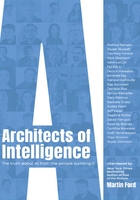
A Brief Introduction to the Vocabulary of AI
The conversations in this book are wide-ranging and in some cases delve into the specific techniques used in AI. You don’t need a technical background to understand this material, but in some cases you may encounter the terminology used in the field. What follows is a very brief guide to the most important terms you will encounter in the interviews. If you take a few moments to read through this material, you will have all you need to fully enjoy this book. If you do find that a particular section is more detailed or technical than you would prefer, I would advise you to simply skip ahead to the next section.
MACHINE LEARNING is the branch of AI that involves creating algorithms that can learn from data. Another way to put this is that machine learning algorithms are computer programs that essentially program themselves by looking at information. You still hear people say “computers only do what they are programmed to do…” but the rise of machine learning is making this less and less true. There are many types of machine learning algorithms, but the one that has recently proved most disruptive (and gets all the press) is deep learning.
DEEP LEARNING is a type of machine learning that uses deep (or many layered) ARTIFICIAL NEURAL NETWORKS—software that roughly emulates the way neurons operate in the brain. Deep learning has been the primary driver of the revolution in AI that we have seen in the last decade or so.
There are a few other terms that less technically inclined readers can translate as simply “stuff under the deep learning hood.” Opening the hood and delving into the details of these terms is entirely optional: BACKPROPAGATION (or BACKPROP) is the learning algorithm used in deep learning systems. As a neural network is trained (see supervised learning below), information propagates back through the layers of neurons that make up the network and causes a recalibration of the settings (or weights) for the individual neurons. The result is that the entire network gradually homes in on the correct answer. Geoff Hinton co-authored the seminal academic paper on backpropagation in 1986. He explains backprop further in his interview. An even more obscure term is GRADIENT DESCENT. This refers to the specific mathematical technique that the backpropagation algorithm uses to the reduce error as the network is trained. You may also run into terms that refer to various types, or configurations, of neural networks, such as RECURRENT and CONVOLUTIONAL neural nets and BOLTZMANN MACHINES. The differences generally pertain to the ways the neurons are connected. The details are technical and beyond the scope of this book. Nonetheless, I did ask Yann LeCun, who invented the convolutional architecture that is widely used in computer vision applications, to take a shot at explaining this concept.
BAYESIAN is a term that can be generally be translated as “probabilistic” or “using the rules of probability.” You may encounter terms like Bayesian machine learning or Bayesian networks; these refer to algorithms that use the rules of probability. The term derives from the name of the Reverend Thomas Bayes (1701 to 1761) who formulated a way to update the likelihood of an event based on new evidence. Bayesian methods are very popular with both computer scientists and with scientists who attempt to model human cognition. Judea Pearl, who is interviewed in this book, received the highest honor in computer science, the Turing Award, in part for his work on Bayesian techniques.